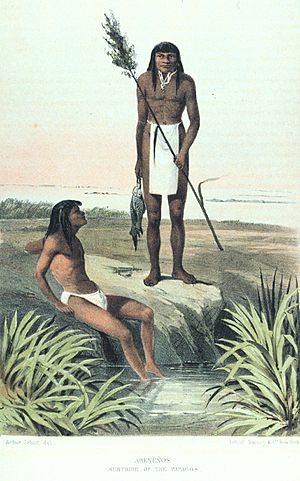Hia C-eḍ Oʼodham facts for kids
Quick facts for kids Hia C-eḍ Oʼodham |
|
|---|---|
| Native American people | |

Two Hia C-eḍ Oʼodham men after a successful fishing expedition. Lithograph from 1857
|
|
| Location | Ajo Range, the Gila River, the Colorado River, and the Gulf of California |
The Hia C-eḍ Oʼodham are a Native American group. Their name means "Sand Dune People." They are also known as Areneños or Sand Papagos. Their traditional homeland is in the area between the Ajo Range, the Gila River, the Colorado River, and the Gulf of California.
Today, the Hia C-eḍ Oʼodham are not officially recognized by the governments of the United States or Mexico. However, the Tohono Oʼodham Nation works with them. The Tohono Oʼodham Nation holds land for them. The Hia-Ced Oʼodham Alliance is a community group that represents them.
The Hia C-eḍ Oʼodham no longer live a nomadic life. Most of them now live in or near Ajo, Arizona. Others live in small towns like Blaisdell and Dome, near Yuma.
Experts have often seen the Hia C-eḍ Oʼodham as a smaller group within the "Papago" people. This group also includes the Tohono Oʼodham and other groups. People with Hia C-eḍ Oʼodham family history can apply to join the Tohono Oʼodham Nation. Some Hia C-eḍ Oʼodham people are also members of the Ak-Chin Indian Community.
In 2009, the Tohono Oʼodham Nation bought land near Why, Arizona. This land was set aside for the Nation. The plan was to create a new area for the Hia C-eḍ Oʼodham. In 2012, a new tribal law created the "Hia Ced District." This became the 12th district of the Tohono Oʼodham Nation. The land near Why was its first home.
For three years, members of the Tohono Oʼodham Nation could ask to join this new district. New people joining the tribe could also choose the Hia Ced District. However, there were problems with how the district was managed. In 2015, voters of the Tohono Oʼodham Nation decided to close the district. Its land and money went back to the Nation. Members returned to their previous districts.
In 2015, former leaders of the Hia Ced District started a new group. It is called Hia-Ced Hemajkam, LLC. Their goal is to get the Hia C-eḍ Oʼodham officially recognized. They want them to be seen as a separate Native American tribe by the United States government.
Contents
Understanding the Oʼodham People
The Oʼodham people include several related groups. Here is a look at how the Hia C-eḍ Oʼodham compare to others:
| Hia C-eḍ Oʼodham | Tohono Oʼodham | Akimel Oʼodham | |
|---|---|---|---|
| Traditional homeland | Between the Ajo Range, the Gila River, the Colorado River and the Gulf of California | Desert south of the Gila River | Land around the Gila and Salt Rivers |
| Meaning of endonym | Sand Dune People | Desert People | River People |
| How they lived | Nomadic (moved around a lot) | Lived in different places for winter and summer | Lived in the same villages all year |
| How they got food | Almost 100% hunting and gathering | 75% hunting and gathering, 25% farming | 40% hunting and gathering, 60% farming |
Hia C-eḍ Oʼodham Culture
The Hia C-eḍ Oʼodham lived close to the Yuman peoples. Because of this, they shared some cultural ways. Some people believe their culture was more like the Yuman people's. However, their language was still Oʼodham. Historical records show that the Hia C-eḍ Oʼodham were friendly with the Cocopah, the Quechan, and the Halchidhoma tribes.
Traditional Food and Hunting
The Hia C-eḍ Oʼodham traditionally found their food by hunting and gathering. They were skilled hunters. They would chase down jackrabbits in the sand. They also hunted mountain sheep, mule deer, and pronghorn using bows and arrows. Smaller animals like muskrats and lizards were also part of their diet.
During certain times of the year, they traveled to the Gulf of California. There, they would fish and collect salt.
They also gathered many plants for food. One special plant was Pholisma sonorae, an edible flower stalk. It is also called camote and "sand food." This plant grows in the sand dunes. They also ate mesquite beans, saguaro fruit, and pitaya. They gathered these fruits near Quitobaquito and the Lower Sonoita River.
See also
 In Spanish: Areneños para niños
In Spanish: Areneños para niños

